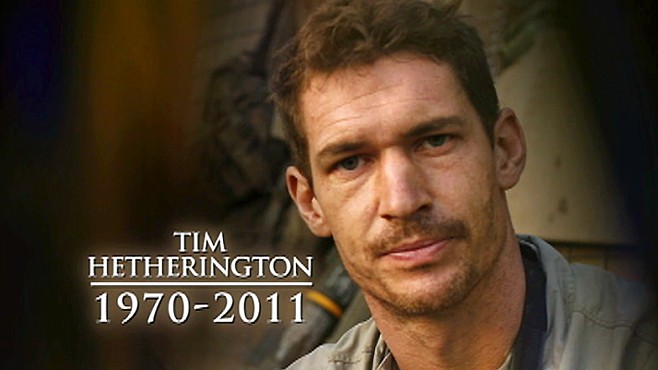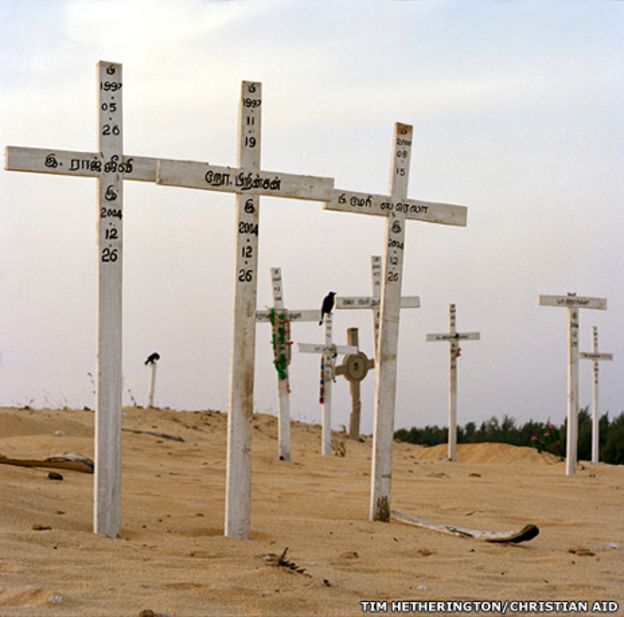Saturday, December 3, 2016
Photojournalist Profile
Disclaimer: This is a first person fictional blog to honor and give light to one of the greatest photojournalists in recent times, Tim Hetherington.
Photo by: Unknown
Image Source: http://abcnews.go.com/International/restrepo-director-tim-hetherington-chris-hondros-killed-libya/story?id=13418813
Welcome to my blog. My name is Tim Hetherington and I am a British born photojournalist. Here you will be able to see some of my work and I will include a brief background of my work and experiences.
Career Path
A bit into my background; I studied Literature at Oxford University and worked in book publishing until 1996. I spent about two years in India, and when I returned, everyone asked how it went, but I couldn’t fully express how amazing my experiences were. Then, a friend of mine took me to see a French film called Sans Soleil, and it expressed on screen everything that I felt inside that I couldn’t express in words. From there, I decided to change my profession to photography and found my passion in photographing real issues going on in our world. I started working as a staff photographer for “The Big Issue” magazine. This magazine was sold by the homeless and long term unemployed. I liked photographing serious topics, and despised getting celebrity assignments. So, while still working at the UK, I heard of a football team of ex-combatants coming for three weeks on tour. I found out that a non-governmental organization was organizing this event, and they told me that they were looking for someone to go to Liberia to photograph the guys playing. I jumped at the opportunity and was blown away by it. One of the pictures I took there won second prize at the World Press Photo. This catapulted my career and led to me working in nearly thirty countries across Africa. I consider myself a war or conflict freelance photographer and filmmaker. I lived about eight years in West Africa, trying to document the effects of civil war in civilians daily lives. Back in 2007, I began a yearlong assignment with a fellow Vanity Fair contributor and friend, Sebastian Junger. We followed a battalion of American troops in Afghanistan and this became the basis of our documentary called “Restrepo”. It was nominated for an Oscar in 2010 and I invite everyone to watch it.
Image Source: https://lindapittwood.org/2013/12/23/you-never-see-them-like-this-tim-hetherington/
In the principles, I chose the following ones, what feelings does the image create? After doing my research, I found this picture from when Tim was working in Afghanistan. The film Restrepo, was not just documenting the soldiers at war, but their downtime, the moments of boredom and silliness, and this image made me feel like they are just like any 20 something year old man, that when bored, they play video games. It was a relaxing moment for them while surrounded by all the chaos. The second principle I used was Quality of Light. The quality of light is very poor. You can barely see the other guy sitting next to him. It makes the environment look dark, depressing, and unsanitary. The third principle I used was does the image remind you of any work of art or photograph you have seen? The image does not remind me of other work I have seen. This image look kind of amateur although I know it is not. It just looks very natural like Tim put no effort into the image, yet was able to still make it mean something.
Era
I have been a photojournalist for over ten years, starting off in the late 1990’s until 2011. I worked in a time where there was much conflict, post 9/11. As my dear friend, Sebastian Junger explained, “the role of the war photographer might seem obsolete, but no. Today’s conflicts demand experienced chroniclers to record a nuanced truth- and to counter the rampant distortion and propaganda of the Digital Age”.
Motivation
I like to call myself a documentary image maker, still and moving, because the real world on the agenda is really important at a time when we’re increasingly disconnected from parts of the world on whom we depend. Many people fail to realize that documenting war and conflicts in war torn countries, is very dangerous and you can’t just land in the middle of a battle, unprepared for the realities of war. I saw an unbelievable number of young kids running around Libya with cameras unprepared for the realities of war.
Image source: http://www.foto8.com/issue05/liberiasoc01.html
In the principles, I used Is the image Black & White or in color? The image is in black and white by choice. It made the image have a deeper meaning instead of just kids playing in the street. It gives it a somber feeling. The second principle used is the use of lines. The lines helps the main focus to be centered in the middle box. The third principle used is the use of shadows. The shadows of the lines or the rods shows the image of destruction yet happiness as the children play.
Technology
When I began covering war, I photographed in medium format in 2002. This made the photos look more natural and made it so I also had the ability to enlarge the pictures on gallery walls if needed. Black and white seemed to me a very clichéd view of Africa, so I began using color. The camera I used for stills was the 5D. I usually shot with a 28-70, sometimes a 135 prime. I shoot manual sometimes; sometimes I shoot Program and under-rate it, depending on the light. I just do whatever works. I used medium format cameras loaded with color negative film, making my images thoughtful rather than exploitive. Here is the thing, documentary photography is depleted in its traditional form. The production and distribution of images is rapidly shifting and it’s not enough for a photographer to just make pictures, you have to consider who has access and how the images are experienced.
Ethics
Every filmmaker or photographer asks themselves how they want to portray the subjects of their film, what to shoot or not to shoot, how to edit so that the film stays true to its topic and subjects, but still compels the audience. While filming Restrepo, we put ourselves in the same risk as the soldiers we were documenting. Junger and I followed these soldiers into battle and recorded the terrible fear and tension, we both were injured at times. Yet the fact that we kept coming back, gave us a ton of credibility with the soldiers. We tried not to record injured American soldiers, to ask their permission if they were used. Besides, we did not want a graphic representation of violence that would distract the message we were trying to show.
Image Source: http://wearetheperiscope.com/detail.php?id=29
In the principles, I used exposure time, because this group of what I am assuming is rebels, are in motion kind of in a march. Since they are moving it is hard to capture them and not have the image come out as clear as it did, so a fast shutter speed must have been used. The second principle used is in or out of focus, because they are in focus but the background is out of focus. This help the focus stay on them and not distract the viewer with them background. The third principle was background compliments or detract from composition. I chose this principle for the same reason as the previous principle. If the background was in focus, it would have competed for attention. since it is out of focus it compliments the picture.
Bias
Through my work, I tried my hardest to remain impartial and unbiased. I also tried to cover conflicts that would not otherwise be fully covered via mainstream media outlets. My goal is to give view into conflicts that others would not necessarily know about. My view is that we’re journalists, so our default position is we’re not writing an editorial. We are trying to bring information to our readers, viewers, so that they can make their own conclusions. In some of my work, there may be some sense of political or social bias, but that judgment would be left for the viewer of my images.
Impact
As I am no longer here anymore, I often wonder what my impact was. My life was tragically cut short on 2011, by a mortar round while I was unassigned. I was covering armed conflict in Libya. I look down to see how my dear friends and colleagues describe how much of an impact I had not just on them, but with the world. According to Kenneth Roth, the executive director of Human Rights Watch says, “he had an extraordinary talent for documenting, in compassionate and beautiful imagery, the human stories behind the headlines”, and the organization further claims to say that “in every assignment, he demonstrated a remarkable sensitivity to his subjects, a tender insight into their human ordeals, and a keen sense of how visual imagery could be used to effect positive social change”. I hope that during my short time in the photojournalism world, I was able to do that.
Image Source: http://www.bbc.com/news/magazine-30376169
The principle I used was Keep it simple. Not much is needed to get the point across that a tragedy occurred there. This was taken after the 2004 tsunami, when Tim traveled there to capture images and talk to the communities affected by it. Those in that village made a grave for their lost love ones on top of a hill. The second principle is contrast appropriate. There really isn't a difference between the light and dark areas, hence the contrast is low. It helps make the image feel calm or relaxed, like it is a somber place to visit. The last principle used obvious main subject, about 1/4 to 2/3 of image area. The image's main subject is about 2/3 of the whole image. There are other crosses in the background but the main ones are the three in the front. It does not crowd the edges and the impact of the image would be lost if the images were not there.
Viewpoints
I am described as insightful, committed to the people I told the stories of, and empathetic. James Brabazon says, “I learned from Tim that without curiosity there can be no message, no image, no truth. That beauty is not inferior to truth; and that truth is not tempered by beauty”. Art Blundell says “he looked for the special thing about you, and that inspired you to look at the people around you with new eyes. Yet with every image he took, it is the photographer whose soul is tortured”.
Your Major at AIC
I am a senior Nursing Student at AIC. Photojournalism and Nursing seems like polar opposite careers. But, if you really think about Tim’s ideology and goals, he wanted to create social change by creating stories through images. He showed the humanity behind the conflict and treated his subject’s with dignity and respect. How is that any different than the core values instilled in every nurse’s education.
Photo By: Odd Anderson
Image Source: http://www.npr.org/sections/pictureshow/2011/05/09/136053477/the-perilous-job-of-conflict-photography
Subscribe to:
Post Comments (Atom)






No comments:
Post a Comment